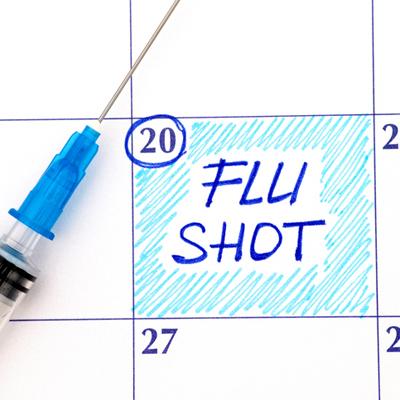
We all know that feeling: the throat and body aches, chills, and fever. It’s the flu. With a season that spans from October to May, the flu virus can knock people off their feet for up to 2 weeks, and antibiotics can’t help. An annual flu shot can protect you from the worst symptoms of the flu. The Centers for Disease Control and Prevention (CDC) recommend one for almost everyone aged 6 months and older, including people with cancer. Some people, like those with a severe egg allergy, should discuss with their doctor before getting a flu shot. Despite this wide recommendation, only around 40% of adults get a flu shot each year.
Avoiding the flu is very important if you are age 65 years or older, are in long-term care, have lung diseases like asthma, or have a weakened immune system because of cancer. For people in these high-risk groups, the flu can be more serious and can lead to dehydration, other infections like pneumonia, and hospitalization.
Most cancers do not increase a person’s risk of catching the flu, but having cancer can weaken the body’s ability to fight the flu if:
-
Cancer treatments block the body’s immune response
-
Leukemias or lymphomas lower immune cell counts
-
Long-term side effects weaken the lungs or other sites of secondary infections
Anytime Is a Good Time for a Flu Shot 
Although the flu begins to spread in October, you can be protected by a flu shot anytime during flu season, especially before the likely peak in January. The immune response starts right after the shot is given (this is what causes the achiness some people feel after a flu shot), but it takes the body about 2 weeks to build up to its full defense. Even if the flu strains change or if you get the flu soon after a shot, any amount of protection reduces the symptoms and shortens how long you may have the flu. A flu shot does not cause the flu.
This year, only shots with inactivated virus are recommended, because they protect better than the nasal spray flu vaccine used in previous years. There are 5 ways to receive a flu shot this year:
-
Standard shots given into the arm muscle with a jet injector (for ages 18 to 64 years) or needle
-
A small-needle shot into the skin (for ages 18 to 64 years)
-
Shots with recombinant or cell-based vaccines not made in eggs
-
High-dose shots for people 65 or older, who need a bigger dose to build the same immune defense as younger people
-
A new adjuvant-vaccine combination shot for people 65 or older, to boost the body’s response to the vaccine
More than 90 million flu shots have been distributed so far this year, and up to 70 million more are planned. Shots have never been easier to get, either: you can walk in to health clinics, urgent care centers, and pharmacies (even in grocery stores) and get one—sometimes with little to no co-pay, depending on your health insurance coverage.
A Few More Things to Know
Ask your family and close friends to get a flu shot, too. The more people who get flu shots around you, the more you can avoid the flu virus during or after cancer treatment.
Sometimes, you should wait to receive the flu shot:
-
If you have a fever or cold, wait up to 1 week after you feel better.
-
After bone marrow transplantation, it may take 4 to 12 months before immune cell counts are high enough for a vaccine to work.
-
During cancer treatment, the vaccine still works, but timing of it for the best response should be decided by your doctor.
And remember, the shot is just 1 tool in an arsenal of protections against the flu and its complications:
-
Wear a mask in places with sick people, like clinic waiting rooms
-
Avoid large crowds, especially groups of young children
-
Keep 6 feet between you and people who appear ill
-
Wash your hands well and often
-
Avoid touching your face with your hands
With a quick flu shot this fall, you can lessen or prevent the flu and avoid more serious illnesses all winter long.
